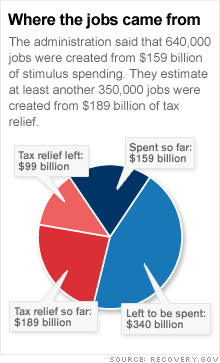Stimulus jobs: 5 questions, 5 answers
How are the jobs calculated? How long do they last? What kind of jobs have been created? How much do jobs cost? We break it down for you.

NEW YORK (CNNMoney.com) -- The Obama administration said Friday that stimulus has created or saved 640,000 jobs so far.
But what does that mean exactly? Have that many people been hired? Here's a quick guide to understanding just what those numbers mean:
1) How are the jobs calculated? It isn't as simple as "one person hired equals one job created," or even "one person retained equating to one job saved."
The government instructed stimulus recipients to report jobs created or saved as "full-time equivalents." If that sounds complicated ... it is.
Full-time equivalents are calculated by adding up the total number of man hours being funded by stimulus for the duration of the contract. That number is then divided by the total number of hours a regular full-time employee would work during the same time period.
For example, say a contractor received a one-year stimulus contract and used those funds to hire a technician for 40 hours a week and an electrician for 20 hours a week for the full year. In addition, the contractor hired a surveyor to work 40 hours a week for six months. In the end, the three employees worked a combined average of 80 hours a week over the course of the year, so the company would have reported that it created two jobs.
Keep in mind, the government's tally only includes those jobs created directly as a result of stimulus projects and activities. It does not include any jobs that may have been saved or created from the American Recovery and Reinvestment Act's $288 billion of tax relief. The total also excludes jobs indirectly created by stimulus, like companies that make materials for a stimulus-funded bridge.
2) How long do the jobs last? Some of the jobs last for the complete duration of the stimulus contracts, which vary in length from a month to several years. But many of the jobs are temporary positions and last for just weeks.
A number of jobs were already in place before the Recovery Act was signed, and stimulus recipients reported that they were able to save those jobs as a result of the stimulus money. Most of those jobs don't have a fixed timeframe, and those positions could be retained after the stimulus money runs out if the employers are able to keep the saved employees on their payrolls.
In the end, it depends on the nature of the job and the stimulus project to determine how long the jobs will last.
3) What kind of jobs has stimulus created or saved? The full reports have not yet been released, but an early glimpse at the data show that stimulus has created or saved jobs from a wide variety of industries.
For private companies that received money directly from the government, most of the jobs that were saved or created were construction jobs for highway, building or nuclear facility dismantling projects. But some of the biggest non-construction job creators came from other fields, like people hired to process and deliver turkey to food banks or oceanographers in the Gulf of Mexico.
4) Who reports the data? Any business, state or local government that has received stimulus funds directly from the federal government is required to report on how many jobs they saved or created.
Those "prime recipients" of stimulus funds often send the money to "sub-recipients." In the case of stimulus money that went to state and local governments, those sub-recipients include schools, construction companies and hospitals. In most cases, the prime recipients report on job creation on behalf of the sub-recipients, but in some cases both report separately.
The government is not allowed to change the reports in any way in order to maintain a certain level of transparency. If errors are found in the data, the government agencies can suggest that changes be made, but cannot actually change the data themselves.
5) What is the cost breakdown? The whole Recovery Act is $787.2 billion. That breaks down into two broad categories: spending and tax relief. Of the $499 billion in spending provisions, $159 billion has been spent so far. Of the $288 billion in tax relief, $189 billion has made its way out the door.
Since the jobs reporting only comes from the spending portion, it is impossible to know the true cost to taxpayers for each job created or saved. But based on the spending portion, taxpayers paid about $248,000 per job created.
Do you have a job because of the $787 billion stimulus package? We want to hear from people whose jobs have been created or saved by the American Recovery and Reinvestment Act. Please e-mail your stories to CNNMoney.com and you could be part of an upcoming article. For the CNNMoney.com Comment Policy, click here. ![]()


